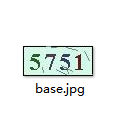本文小编为大家详细介绍“怎么使用Python+OpenCV实现图像识别替换功能”,内容详细,步骤清晰,细节处理妥当,希望这篇“怎么使用Python+OpenCV实现图像识别替换功能”文章能帮助大家解决疑惑,下面跟着小编的思路慢慢深入,一起来学习新知识吧。
OpenCV-Python是一个Python库,旨在解决计算机视觉问题。
OpenCV是一个开源的计算机视觉库,1999年由英特尔的Gary Bradski启动。Bradski在访学过程中注意到,在很多优秀大学的实验室中,都有非常完备的内部公开的计算机视觉接口。这些接口从一届学生传到另一届学生,对于刚入门的新人来说,使用这些接口比重复造轮子方便多了。这些接口可以让他们在之前的基础上更有效地开展工作。OpenCV正是基于为计算机视觉提供通用接口这一目标而被策划的。
安装opencv
pip3 install -i https://pypi.doubanio.com/simple/ opencv-python
思路:
1、首先区分三张图片:
base图片代表初始化图片;
template图片代表需要在大图中匹配的图片;
white图片为需要替换的图片。



2、然后template图片逐像素缩小匹配,设定阈值,匹配度到达阈值的图片,判定为在初始图片中;否则忽略掉。
3、匹配到最大阈值的地方,返回该区域的位置(x,y)
4、然后用white图片resize到相应的大小,填补到目标区域。
match函数:
"""检查模板图片中是否包含目标图片"""
def make_cv2(photo1, photo2):
global x, y, w, h, num_1,flag
starttime = datetime.datetime.now()
#读取base图片
img_rgb = cv2.imread(f'{photo1}')
#读取template图片
template = cv2.imread(f'{photo2}')
h, w = template.shape[:-1]
print('初始宽高', h, w)
res = cv2.matchTemplate(img_rgb, template, cv2.TM_CCOEFF_NORMED)
print('初始最大相似度', res.max())
threshold = res.max()
""",相似度小于0.2的,不予考虑;相似度在[0.2-0.75]之间的,逐渐缩小图片"""
print(threshold)
while threshold >= 0.1 and threshold <= 0.83:
if w >= 20 and h >= 20:
w = w - 1
h = h - 1
template = cv2.resize(
template, (w, h), interpolation=cv2.INTER_CUBIC)
res = cv2.matchTemplate(img_rgb, template, cv2.TM_CCOEFF_NORMED)
threshold = res.max()
print('宽度:', w, '高度:', h, '相似度:', threshold)
else:
break
"""达到0.75覆盖之前的图片"""
if threshold > 0.8:
loc = np.where(res >= threshold)
x = int(loc[1])
y = int(loc[0])
print('覆盖图片左上角坐标:', x, y)
for pt in zip(*loc[::-1]):
cv2.rectangle(
img_rgb, pt, (pt[0] + w, pt[1] + h), (255, 144, 51), 1)
num_1 += 1
endtime = datetime.datetime.now()
print("耗时:", endtime - starttime)
overlay_transparent(x, y, photo1, photo3)
else:
flag = Falsereplace函数:
"""将目标图片镶嵌到指定坐标位置"""
def overlay_transparent(x, y, photo1, photo3):
#覆盖图片的时候上下移动的像素空间
y += 4
global w, h, num_2
background = cv2.imread(f'{photo1}')
overlay = cv2.imread(f'{photo3}')
"""缩放图片大小"""
overlay = cv2.resize(overlay, (w, h), interpolation=cv2.INTER_CUBIC)
background_width = background.shape[1]
background_height = background.shape[0]
if x >= background_width or y >= background_height:
return background
h, w = overlay.shape[0], overlay.shape[1]
if x + w > background_width:
w = background_width - x
overlay = overlay[:, :w]
if y + h > background_height:
h = background_height - y
overlay = overlay[:h]
if overlay.shape[2] < 4:
overlay = np.concatenate([overlay, np.ones((overlay.shape[0], overlay.shape[1], 1), dtype=overlay.dtype) * 255],axis=2,)
overlay_image = overlay[..., :3]
mask = overlay[..., 3:] / 255.0
background[y:y + h,x:x + w] = (1.0 - mask) * background[y:y + h,x:x + w] + mask * overlay_image
# path = 'result'
path = ''
cv2.imwrite(os.path.join(path, f'1.png'), background)
num_2 += 1
print('插入成功。')
init()每次执行需要初始化x,y(图片匹配初始位置参数),w,h(图片缩放初始宽高)
x = 0 y = 0 w = 0 h = 0 flag = True threshold = 0 template = '' num_1 = 0 num_2 = 0 photo3 = '' """参数初始化""" def init(): global x, y, w, h, threshold, template,flag x = 0 y = 0 w = 0 h = 0 threshold = 0 template = ''
完整代码
import cv2
import datetime
import os
import numpy as np
x = 0
y = 0
w = 0
h = 0
flag = True
threshold = 0
template = ''
num_1 = 0
num_2 = 0
photo3 = ''
"""参数初始化"""
def init():
global x, y, w, h, threshold, template,flag
x = 0
y = 0
w = 0
h = 0
threshold = 0
template = ''
"""检查模板图片中是否包含目标图片"""
def make_cv2(photo1, photo2):
global x, y, w, h, num_1,flag
starttime = datetime.datetime.now()
img_rgb = cv2.imread(f'{photo1}')
template = cv2.imread(f'{photo2}')
h, w = template.shape[:-1]
print('初始宽高', h, w)
res = cv2.matchTemplate(img_rgb, template, cv2.TM_CCOEFF_NORMED)
print('初始最大相似度', res.max())
threshold = res.max()
""",相似度小于0.2的,不予考虑;相似度在[0.2-0.75]之间的,逐渐缩小图片"""
print(threshold)
while threshold >= 0.1 and threshold <= 0.83:
if w >= 20 and h >= 20:
w = w - 1
h = h - 1
template = cv2.resize(
template, (w, h), interpolation=cv2.INTER_CUBIC)
res = cv2.matchTemplate(img_rgb, template, cv2.TM_CCOEFF_NORMED)
threshold = res.max()
print('宽度:', w, '高度:', h, '相似度:', threshold)
else:
break
"""达到0.75覆盖之前的图片"""
if threshold > 0.8:
loc = np.where(res >= threshold)
x = int(loc[1])
y = int(loc[0])
print('覆盖图片左上角坐标:', x, y)
for pt in zip(*loc[::-1]):
cv2.rectangle(
img_rgb, pt, (pt[0] + w, pt[1] + h), (255, 144, 51), 1)
num_1 += 1
endtime = datetime.datetime.now()
print("耗时:", endtime - starttime)
overlay_transparent(x, y, photo1, photo3)
else:
flag = False
"""将目标图片镶嵌到指定坐标位置"""
def overlay_transparent(x, y, photo1, photo3):
y += 0
global w, h, num_2
background = cv2.imread(f'{photo1}')
overlay = cv2.imread(f'{photo3}')
"""缩放图片大小"""
overlay = cv2.resize(overlay, (w, h), interpolation=cv2.INTER_CUBIC)
background_width = background.shape[1]
background_height = background.shape[0]
if x >= background_width or y >= background_height:
return background
h, w = overlay.shape[0], overlay.shape[1]
if x + w > background_width:
w = background_width - x
overlay = overlay[:, :w]
if y + h > background_height:
h = background_height - y
overlay = overlay[:h]
if overlay.shape[2] < 4:
overlay = np.concatenate([overlay, np.ones((overlay.shape[0], overlay.shape[1], 1), dtype=overlay.dtype) * 255],axis=2,)
overlay_image = overlay[..., :3]
mask = overlay[..., 3:] / 255.0
background[y:y + h,x:x + w] = (1.0 - mask) * background[y:y + h,x:x + w] + mask * overlay_image
# path = 'result'
path = ''
cv2.imwrite(os.path.join(path, f'1.png'), background)
num_2 += 1
print('插入成功。')
init()
if __name__ == "__main__":
photo1 = "1.png"
photo2 = "3.png"
photo3 = "white.png"
while flag == True:
make_cv2(photo1, photo2)
overlay_transparent(x, y, photo1, photo3)执行结果:

读到这里,这篇“怎么使用Python+OpenCV实现图像识别替换功能”文章已经介绍完毕,想要掌握这篇文章的知识点还需要大家自己动手实践使用过才能领会,如果想了解更多相关内容的文章,欢迎关注亿速云行业资讯频道。
免责声明:本站发布的内容(图片、视频和文字)以原创、转载和分享为主,文章观点不代表本网站立场,如果涉及侵权请联系站长邮箱:is@yisu.com进行举报,并提供相关证据,一经查实,将立刻删除涉嫌侵权内容。